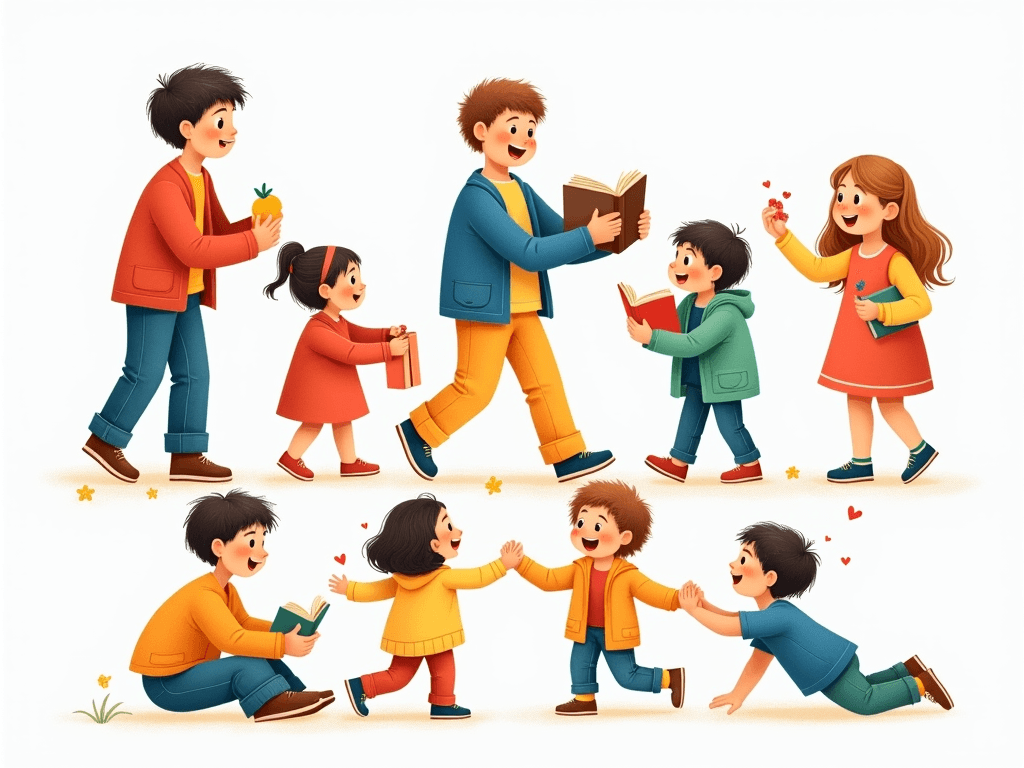Understanding Kindness | TinyTraverse

Kindness
Join the Emotion Explorers and learn about Kindness! Fun activities and tips for kids ages 5-11 to develop emotional intelligence with TinyTraverse.
Introduction
- Imagine you’re at the lunch table, and you see a friend without a snack. You offer to share yours — that's kindness in action! Understanding kindness helps us create friendships and happier communities. Welcome to the TinyTraverse Emotion Explorers series, where we’ll uncover the magic of being kind!
Definition
- Kindness is when we act in a caring and helpful way towards others. It's like the warm sun that makes flowers bloom or a cozy blanket that makes us feel safe. When you're kind, it often feels like a light, happy feeling inside your chest or a sense of joy in your heart. Kindness can sometimes feel like a bright light that you want to share with others.
Recognition Signs
- A smile lighting up someone's face when they do something nice for a friend.
- Lending a helping hand when someone is struggling.
- Giving a sincere compliment that boosts someone's confidence.
- Sharing what you have, like toys or snacks, with others.
- Listening carefully and offering words of support when someone is upset.
Science Explanation
- Did you know that being kind not only makes others feel good, but it makes you feel good too? That's because acts of kindness release chemicals in our brain called endorphins, which are nature’s feel-good drugs! When you're kind, it also helps your brain grow stronger connections with others, making friendships closer and more meaningful. Imagine your brain lighting up with happiness like a festive holiday light show!
Coping Strategies
- Practice random acts of kindness daily, like leaving a positive note for someone.
- Create a 'Kindness Jar' where you and your family add coins or notes for every kind deed.
- When upset, take deep breaths and think of a happy memory involving kindness.
- Visualize kindness as a superhero power you can activate anytime.
- Write a gratitude journal focusing on kind acts you observed during the day.
Explorer Activities
- Create a 'Kindness Challenge' where you do one kind act every day for a month.
- Make a 'Kindness Map' that shows places at school or home where you can be especially kind.
- Write a short play with friends acting out different scenarios of kindness.
- Host a 'Kindness Bake Sale' where proceeds go to a charity of your choice.
- Start a 'Kindness Club' with friends to plan weekly kindness projects.
Story
- Once upon a time in a colorful town, there was a young boy named Leo who found a lost puppy on his way home. Instead of leaving it, Leo decided to help. He fed the puppy and asked neighbors if they knew the owner. His kindness spread throughout the town, inspiring others to look after one another. Eventually, the puppy's owner was found, and he was so grateful that he gifted Leo a new book.
Discussion Questions:
- How did Leo's act of kindness make a difference?
- Why is it important to help others, even in small ways?
- Can you think of a time when you were kind or when someone was kind to you?
Story Questions
- How did Leo's act of kindness make a difference?
- Why is it important to help others, even in small ways?
- Can you think of a time when you were kind or when someone was kind to you?
Emotion Vocabulary
- undefined: Willingness to give more than is necessary or expected. (Example: Sally showed generosity by donating her toys to the local shelter.)
- undefined: Feeling of sympathy and concern for others. (Example: Tom felt compassion for the stray cat and decided to take it home.)
- undefined: Ability to understand and share the feelings of others. (Example: By listening, Mark showed empathy to his friend who was sad.)
- undefined: Feeling of thankfulness and appreciation. (Example: Jake expressed gratitude when his friend helped him with his homework.)
- undefined: Selfless concern for the well-being of others. (Example: Altruism led Anna to volunteer at a food bank each month.)
Tips for Grownups
- Encourage children to share stories of kindness from their day and celebrate them together.
- Model kindness by showing respect and concern for others in your own actions.
- Create opportunities for children to participate in community service or charity events.
- Discuss with children how they feel when they are kind or receive kindness.
- Provide books and media that highlight themes of kindness and compassion.
Interactive Quiz
Current Score: 0 / 1
What is one way kindness can make a person feel?
Conclusion
- Kindness is a powerful and joyful emotion that enriches our lives and those around us. By exploring and embodying kindness, children learn valuable social skills and emotional understanding. Keep exploring emotions with TinyTraverse's Emotion Explorers series, and discover new ways to grow and connect!